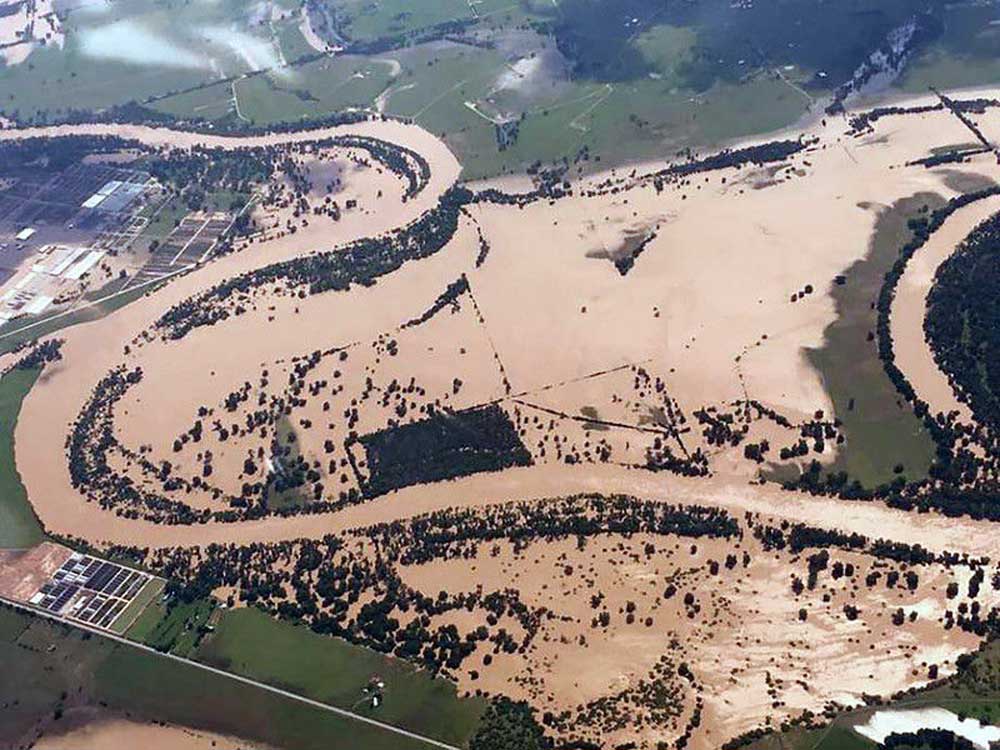Texas lake capacity near record high, flooding shouldn’t affect fisheries
Published 6:42 pm Saturday, June 4, 2016

- COURTESY THIS IS A PHOTO OF THE BRAZOS RIVER in Fort Bend County last weekend taken by astronaut Terry Virts who flew over the area in an airplane. Many of the states river and lakes are more than full this spring.
These are certainly heady days for Texas reservoirs. Back-to-back wet years have put the water capacity behind public dams at the highest capacity it has been since record levels in the early 2000s.
Eighty five of 115 major reservoirs with recorded data were above full capacity last week, putting the combined capacity statewide at al 88 percent. There are only a couple of times since the 1940s that the state has stored more water than right now.
Some of the lakes that are still down, exclusively in West Texas, are down significantly. Others that were down early in the week were running full by Friday.
Compared to the drought years of 2010 and 2011 when ramps were closed and some lakes completely bottomed out, the current conditions are a fisherman’s dream. Fish cover that in a normal year would be high and dry on the lakes is suddenly inundated giving fishermen that much more habitat to cover.
It has also produced excellent cover for this year’s spawn to hide from predators. Coupled with somewhat similar conditions last year on a lot of lakes, it should result in excellent fishing down the road.
“I certainly empathize with those people who’ve lost property or, worse, family members to the flooding. However, I refuse to complain about too much rain. The memory of drought and its effects are still relatively fresh in my mind. A surplus of water can bring its own challenges, but I’ll take it over devastating drought any year,” said Craig Bonds, Texas Parks and Wildlife Department’s Fisheries Director.
In some areas this spring’s rainfall has been crippling and deadly. Entire Texas cities have had to be evacuated because of rising waters on the Brazos most recently. Earlier it was the normally docile Sabine that roared through towns, pastures and pine country. Businesses at Caddo Lake have flooded twice this year alone.
In other cases where the rain has not come in buckets the result has more commonly been flooded boathouses making it impossible for fishermen to get their boats out or temporarily closed ramps that prevent launching.
While generally good news, the high water has created issues for TPWD Fisheries biologists who normally do surveys and of course fish stocking this time of year.
“Flooding can cause some challenges to fisheries management,” Bonds said. “Recovering reservoirs, especially in West and some parts of Central Texas, can place a higher demand on hatchery production to replenish depleted stocks. High reservoir water levels and river flows can prevent planned fish sampling activities from occurring on schedule. Some reservoirs have been so high that controlling authorities have temporarily closed access until water recedes back down toward conservation pool. Radically changing hydrologic conditions can negatively impact fishing conditions.”
He added there is also a concern about potential damage to hatchery facilities located adjacent to flooding rivers or lakes.
But when it comes to fishing, these clouds have a silver lining.
“However, many fish species will experience ideal spawning and juvenile habitat conditions in 2015 and 2016. Strong year-classes of prey and sport fishes will carry fisheries into future years. Some riverine species are adapted to flood pulses and floodplain connectivity. Anthropogenic changes to rivers such as dams, channelization, road culverts, poorly designed bridges, can form barriers to fish movement. Flood pulses can open up new habitats for fish movement into spawning and nursery habitats,” Bonds explained.
When it comes to fish there is no such thing as too much water. Bonds said that even though a large number of lakes have had flushing flows this year that have pushed fish over the dam, that loss does not compare to the gains from inflow water creating new habitat and thus higher productivity.
“Most of the recent flooding has occurred after the bass spawn concluded. This will be a net-positive for survival of young bass and other species,” Bonds said.
Even if the flooding impacts the delivery of bass fingerlings from state hatcheries, that impact too should be minimized by increased natural survival on the rising lakes
Have a comment or opinion on this story? Contact outdoor writer Steve Knight by email at outdoor@tylerpaper.com. Follow Steve Knight on Facebook at Texas All Outdoors and on Twitter @txalloutdoors






